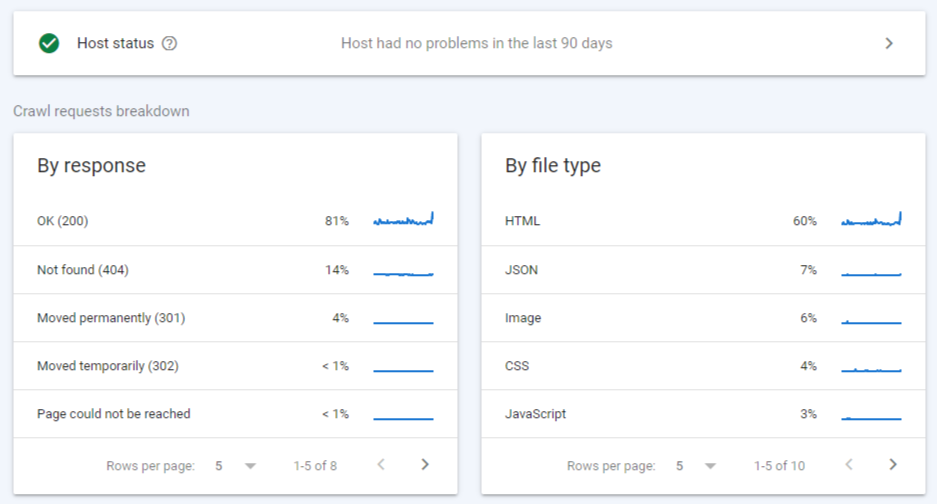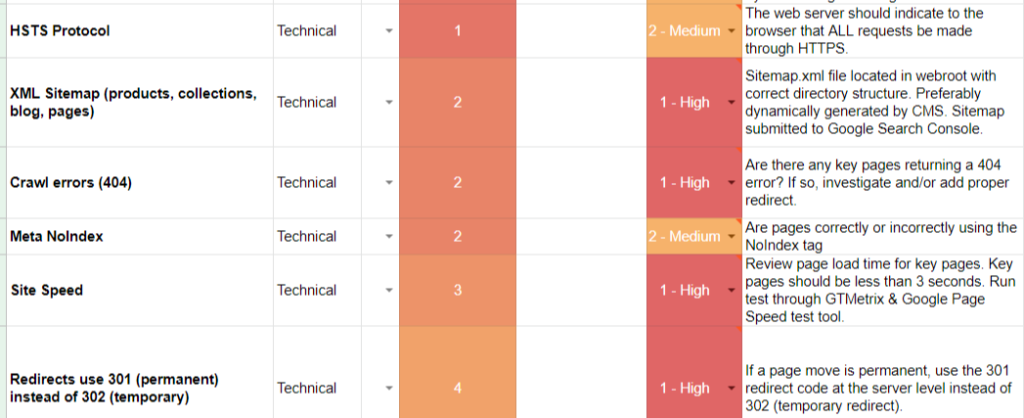As a business owner or marketing leader, I’m sure you get multiple emails per week telling you your site has SEO issues. Many of those emails might include a “free SEO audit”. Here’s the problem:
Most of the time, these free audits are so technical that you don’t understand the report. Even if you do know what a 404 or 301 or HREF LANG tag means, you don’t know what to fix or why. Even worse, many times the report doesn’t expose the real problems holding your site back from achieving top rankings.
Often, the agency sending the email simply ran your site through SEMRush and spit out a white label report.
The key to the success of any enterprise level e-commerce SEO audit is getting an actionable list of improvements to be made, and knowing which to implement first to have the maximum impact.
So what should a good technical SEO Audit for E-Commerce sites contain?
Keeping with technical on-site elements, here are 3 subject areas every SEO audit should include:
- An explanation of how Google is crawling your site
- A complete plan for an Index/NoIndex Strategy
- A workable strategy for fixing issues, and an action plan
1. How is Google Crawling Your Site?
You’ve got quality content. You’ve created short descriptions for your categories, unique product descriptions for your product pages and the blog is growing. You’ve got your XML sitemap. You’re good to go, right?
Not so fast…
How Google and other major search engines crawl and index your site goes far beyond simple sitemaps, linking strategies, and your content quality. While there are more, here’s a few things most audits don’t look at when examining this:
- Googlebot Crawl Budgets
- Javascript that alters website code and content
- Crawling parameters in Search Console and your Robots.txt file
- Canonical URL setups
Let’s have a look at these in a bit more detail.
A crawl budget is an arbitrary number of pages (or resources) Google alots to your website to be crawled every month. Generally speaking, its determined by the size of your site, how well its built, and how many back links you have.

A great technical SEO audit will tell you if there are any issues here, and suggest ways to fix them.
Secondly, some sites leverage Javascript to alter page content. From a technical perspective, this occurs after a page has partially loaded, so it’s possible that Google has crawled and evaluated a page before your Javascript has made its changes.
In short, just because you can see something on your website doesn’t mean that Google can.
Lastly, as I mentioned on my post e-commerce platform migration post last week, there can be hidden little goblins in your Search Console, and/or robots.txt file that can prevent Google from crawling content that you want indexed.
That should be fully explored, and a detailed list what to fix (and how), should be included in the audit.
2. A Complete Index/NoIndex Content Plan
That free “audit” in your inbox this morning? It says you have 23 NoIndexed pages.
My question to you is, “So what?“.
NoIndex pages are perfectly fine. Even having 23 of them is perfectly fine. If that’s the number that makes sense.
Having a strategy for what you want people to find in Google is part and parcel of your overall web presence plan. Far too many websites just allow Google to crawl and index everything, like:
- Shopping Carts
- My Account pages
- Terms & Conditions
- Thank You pages after newsletter signups
- Tag pages in WordPress blogs
All important pages to be sure, but they don’t need to be in the Google index. They can take up your crawl budget, potentially create duplicate content issues, and even make reporting wrong in some instances.
A killer technical SEO audit will give your team direction on which pages to make findable, and which not to. It’s too important to overlook.
3. A Post SEO Audit Strategy and Plan
It’s like the old saying goes: Any teammate can come to you and say there’s a problem. A great teammate, however, will also bring you a workable solution.
Most “audits” you see these days are simply a shopping list of mostly unimportant small technical issues on your site. Yes, it’s important all your page titles are unique, but you knew that already. And sure, all of your images should have ALT text, both for SEO and accessibility purposes.
A great e-commerce SEO audit will go far deeper than that. On top of some things already mentioned in this post, you should be delivered an action plan which includes:
- A proposed solution for each issue identified
- It should assign an owner to fix the issues, either at the agency or on your team
- It should be readable by anyone on your team- it needs to make the technical, simple
- It should force rank/prioritize the issues from high to low, and explain why each problem is ranked that way
- It should include some metrics that predict how fixing issues could impact traffic 6 and 12 months down the road
In a sense, the SEO audit should almost be an outline of your future plan to increase your organic channel traffic. Most of all, it should make you feel as though no stone went unturned, and that the agency knows what they’re talking about.
Your Next Steps to Better Technical SEO
Do your website a favor and go get a full, enterprise level e-commerce SEO audit done. You can read more about ours here.
As mentioned, its all in the level of detail, and a go-forward partnership plan that makes sense.
If you’re hovering just outside the Top 10 in Google for keywords that will grow your business, taking this next step could go a long way towards moving the needle.
Ready to get ranked? We’re ready to help.






